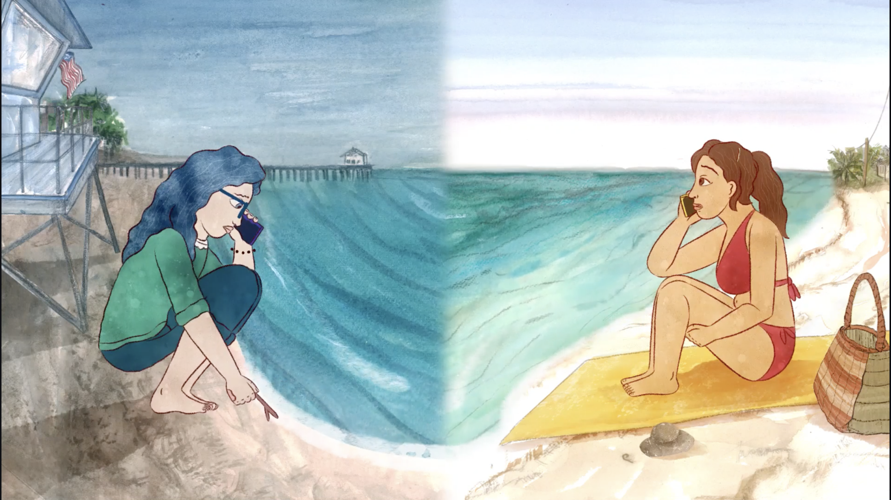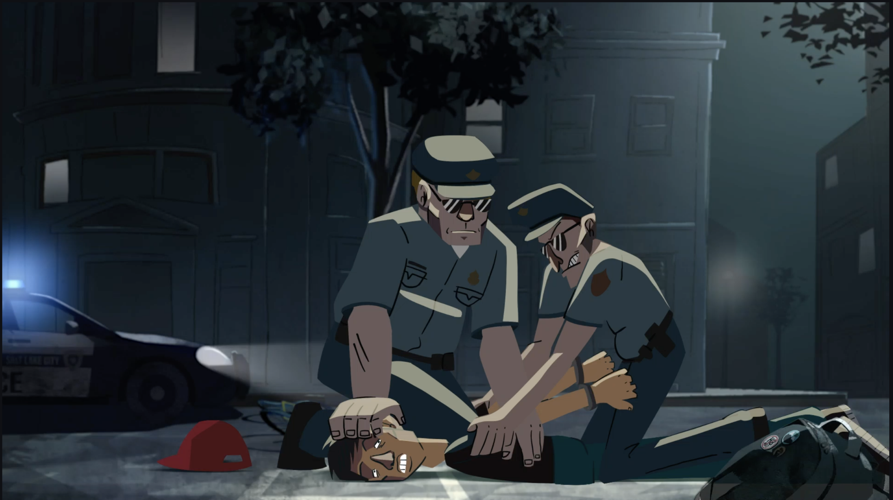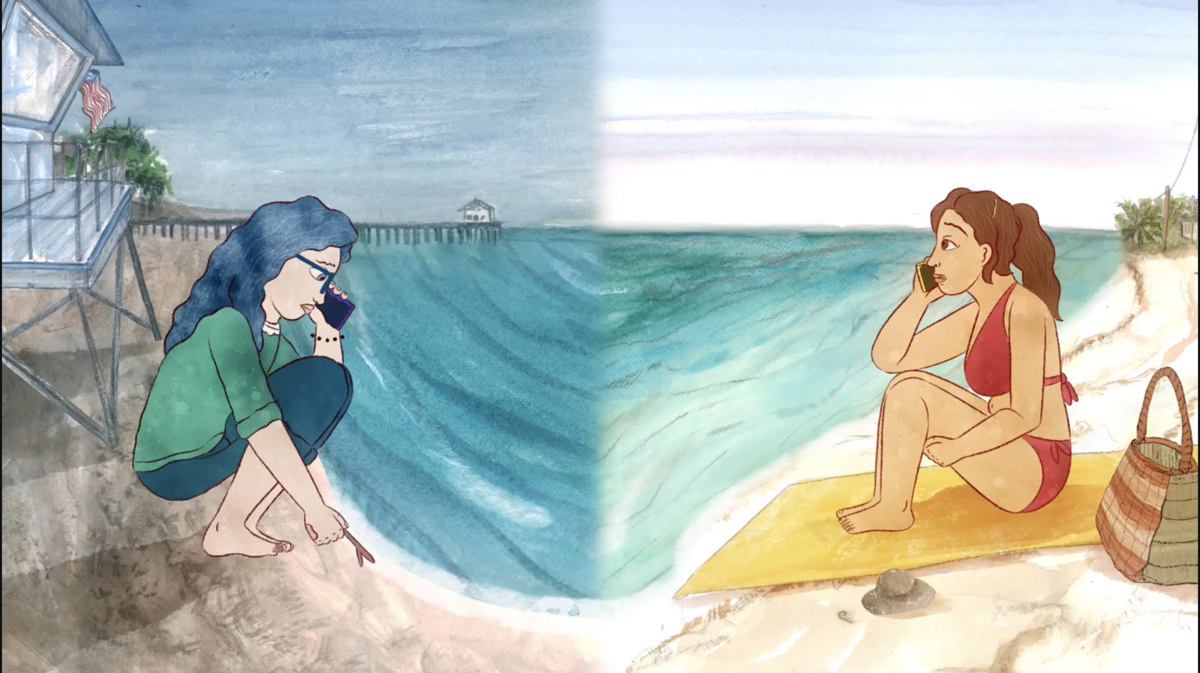The Borderland Film Festival returns to Ambos Nogales this weekend, featuring an award-winning animated documentary to be screened bi-nationally on Friday, on back-to-back screens straddling the U.S.-Mexico border.
The festival's main feature, "Home Is Somewhere Else," is a 2022 film by Mexican co-directors Carlos Hagerman and Jorge Villalobos. It tells the stories of three families of mixed immigration statuses facing the pain of family separation, while grappling with their dreams, joys and fears.
Each storyline is depicted in a different animation style and is based on interviews with real families. The film is narrated by spoken-word poet José Eduardo "Lalo" Aguilar, whose poetic Spanglish unites the three storylines, Hagerman said.
"You get a spectrum of three very different stories with three very different styles of animation. We thought we needed a narrator to hold these three stories together and also to be kind of the emcee of the film," said Hagerman, who was born and raised in Mexico City. He attended New York University’s graduate film program after receiving a Fulbright scholarship.
In a separate event on Wednesday, Oct. 25, Tucson's Loft theater will host a free screening of "Home Is Somewhere Else," followed by a question-and-answer session with Hagerman, who also produced the film.

In one storyline of "Home Is Somewhere Else," a young man — brought to the U.S. at 8 years old — is deported after a random arrest at age 23. The animated documentary is the feature presentation of this year's Borderland Film Festival in Nogales, Ariz., and Nogales, Sonora.
The Borderland Film Festival, which is free to attend, launched in 2010 and is returning after a four-year hiatus, said festival director Samuel Saunders.
Saunders said organizers worked with U.S. Customs and Border Protection to ensure there would be no problems with audiences gathered on both sides of the border to share in Friday's simultaneous screening, which will be held on International Street in Nogales, Ariz., and just across the fence at Calle Internacional in Nogales, Sonora.
On Saturday, Hagerman will host also two animation and film-direction workshops for high school students, in Nogales, Arizona, at 10:30 a.m. and in Nogales, Sonora, at 2 p.m.
For 15 years Hagerman worked on documentaries centered on migration and families before, in 2012, he helped launch an animation studio called Brinca — Spanish for "jump" — harnessing the power of animation to tell true stories, he said.
“Home Is Somewhere Else” is the studio's first feature-length film. Hagerman said its animated style both protects the identities of the film's vulnerable undocumented subjects and draws viewers back to the mindset they may have had as a child watching cartoons, he said.
“When you see an animated feature, you kind of take away the shield that you put on when you're watching a documentary,” he said. “When the documentary is of a different context than you live in, often you very quickly detach yourself from what’s happening to the protagonist, because it’s not your reality.”
But with animated films, viewers open themselves to a graphic world of metaphor, and that opening can also allow for a direct, empathetic connection with the characters, he said.
“I think that’s a very beautiful thing, because you kind of accept the reality of an animation in a very different way than you could accept the reality of a (standard) documentary,” he said.
Animation also afforded the directors the ability do use poetic imagery to represent the internal experiences of its subjects, Hagerman said.
"From the start, we wanted to make a film with a subjective point of view, not an objective point of view, which is normally what documentarians try to do," he said. "We wanted to experience the lives of these protagonists through their point of view."
The first story centers on Jasmine, who came in for a pre-production interview when she was 11 years old. Co-director Villalobos interviewed Jasmine about her experience as a young activist, fighting to keep her family together. To break the ice, he offered her some crayons and paper as they talked, Hagerman said.

The first storyline in "Home Is Somewhere Else" centers on Jasmine, 11, whose drawings became the manual for the animators' depiction of her story, co-director Carlos Hagerman said. "It was very beautiful that it happened that way," he said. "You cannot have something more subjective than listening to the real conversation we had with this girl, and watching — through her drawings — her telling her own story."
When Jasmine shared her drawings afterwards — sketches of her family, her cat and things she liked — the directors decided to use her sketches as the manual for her story's animation style, bringing viewers even closer to the little girl's struggle.
"This was a very unique, very organic way that it happened. It was very beautiful that it happened that way," Hagerman said. "You cannot have something more subjective than listening to the real conversation we had with this girl, and watching – through her drawings — her telling her own story."
The film's second storyline focuses on two sisters, Evelyn and Elizabeth, who are deeply bonded, but separated by their differing immigration statuses. The third story is about a young man brought to the U.S. at 8 years old, whose family built a life in Utah before he was deported after a random arrest at age 23.

The Borderland Film Festival begins in Nogales, Sonora on Thursday with a screening of "Corazón de Mesquite." Its feature presentation is Friday's binational screening of "Home Is Somewhere Else" on back-to-back screens in Nogales, Ariz., and Nogales, Sonora.
"Home Is Somewhere Else" was co-produced by Shine Global, a New York nonprofit that produces documentaries about children's resilience. The documentary's creators have also developed curriculum guides for high school teachers who want to share the film in their classrooms.
Hagerman hopes the film's intimate portraits of real families will elevate discussions of the immigration crisis from depersonalized and divisive, to empathetic and human.
“We believe that if young students, teenagers that are in the most important moment to create their social identity, are exposed to this kind of experience, they might have a different way of looking at their reality when they are adults and they can do something about it," Hagerman said.








